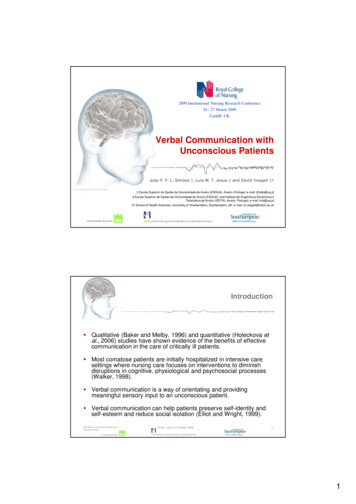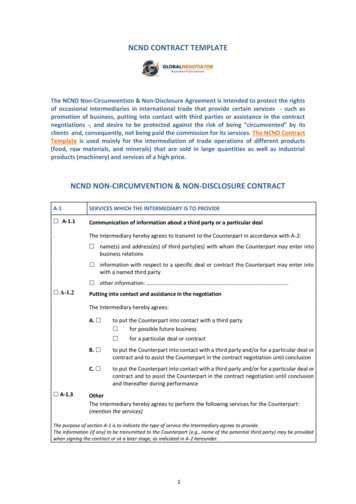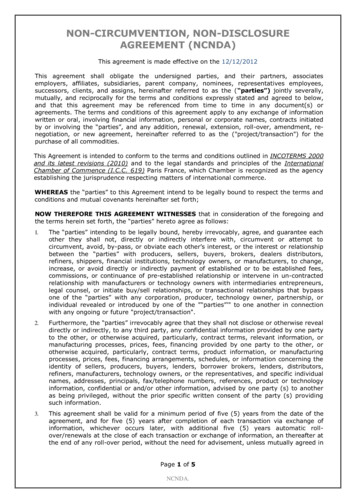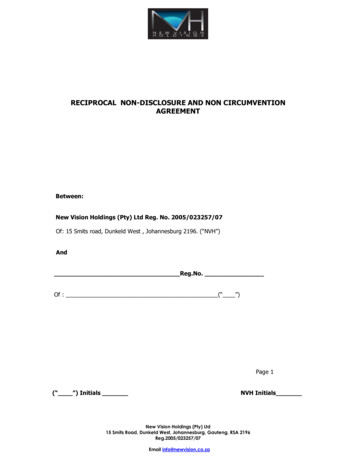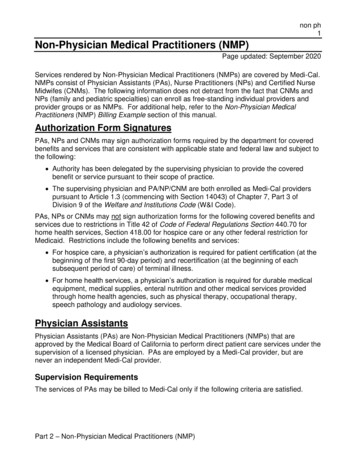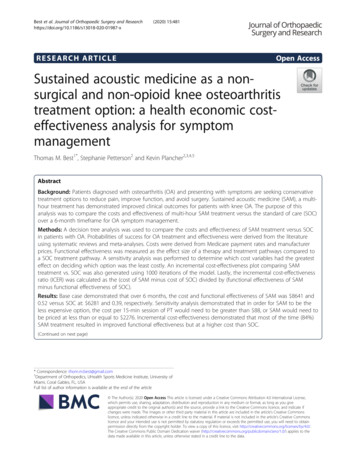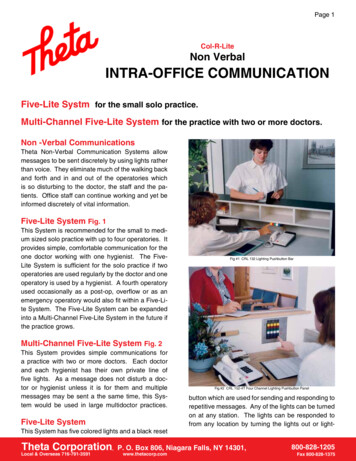
Transcription
Page 1Col-R-LiteNon VerbalINTRA-OFFICE COMMUNICATIONFive-Lite Systm for the small solo practice.Multi-Channel Five-Lite System for the practice with two or more doctors.Non -Verbal CommunicationsTheta Non-Verbal Communication Systems allowmessages to be sent discretely by using lights ratherthan voice. They eliminate much of the walking backand forth and in and out of the operatories whichis so disturbing to the doctor, the staff and the patients. Office staff can continue working and yet beinformed discretely of vital information.Five-Lite System Fig. 1This System is recommended for the small to medium sized solo practice with up to four operatories. Itprovides simple, comfortable communication for theone doctor working with one hygienist. The FiveLite System is sufficient for the solo practice if twooperatories are used regularly by the doctor and oneoperatory is used by a hygienist. A fourth operatoryused occasionally as a post-op, overflow or as anemergency operatory would also fit within a Five-Lite System. The Five-Lite System can be expandedinto a Multi-Channel Five-Lite System in the future ifthe practice grows.Fig #1 CRL 132 Lighting Pushbutton BarMulti-Channel Five-Lite System Fig. 2This System provides simple communications fora practice with two or more doctors. Each doctorand each hygienist has their own private line offive lights. As a message does not disturb a doctor or hygienist unless it is for them and multiplemessages may be sent a the same time, this System would be used in large multidoctor practices.Five-Lite SystemThis System has five colored lights and a black resetTheta Corporation,Local & Overseas 716-791-3591Fig.#2 CRL 152-4T Four Channel Lighting Pushbutton Panelbutton which are used for sending and responding torepetitive messages. Any of the lights can be turnedon at any station. The lights can be responded tofrom any location by turning the lights out or light-P. O. Box 806, Niagara Falls, NY 14301,www.thetacorp.com800-828-1205Fax 800-828-1375
ing additional lights to acknowledge the message.A buzzer sounds at every station as the light is being lit and the buzzer also sounds additional timesas any of the lit buttons are pressed again. Eachbuzzer is adjustable in volume station by station.Five-Lite System Simple Message CodingMessage AcknowledgedResetDoctor wants receptionistReceptionistDoctor’s patient arrivedNext PatientDoctor needed by hygienistHygienistDoctor has telephone callTelephoneDoctor wants assistantAssistantA simple way to code messages is to assign messages to each color of light. As the button is presseda buzz sounds and the light lights and stays lit. Anacknowledgment of “Yes” is sent by pressing theblack reset button, turning out the light. A “No” ordelay reply can be sent by pressing the lit buttonproviding a buzz back to the sender. Messagesfor the doctor can usually be on one color of light:Page 2staff members other than the doctor by adding the staff members color to the message So,“Next Patient” for the doctor was white. “Next Patient” for the hygienist would be white and greenlit together (white is the color for next patient andgreen is the color for hygienist). Common messages sent to staff other than the doctor are:Hygiene (green light for hygienist)Green-White -Hygienist your next patient is hereGreen-Red-Hygienist phone callGreen-Blue -Hygienist needs the receptionistGreen-Yellow-Hygienist needs an assistantAssistant (Yellow light for assistant)Yellow-Red -Assistant phone callYellow-White-Assistant seat patient for doctorYellow-Blue -Assistant needed by receptionistReceptionist (Blue light for receptionist)Blue-Yellow -Receptionist needs assistantBlue-Green -Receptionist needs hygienistIt is important that all message exchanges endwith the lights reset so that the System is available for the next message. The Five-Lite systemshould not be used to indicate status such as roombusy or next patient waiting. Status indicationswould leave the System busy for long periods oftime preventing other messages from being sent.Room Status Systems and Patient Waiting Status Systems are available from Theta Corporation.Rooms other than OperatoriesFig. #3 Sample Message CodingYellowRedGreenWhite by ReceptionistWhite by DoctorBlue by DoctorBlue by receptionist-Assistant needed by doctor-Phone call for doctor-Hygienist needs the doctor-Next patient for doctor-Seat the next patient-Doctor needs receptionist-Receptionist needs doctorThe same coding is used for messages betweenFig.#4 CRL 152 Lighting Pushbutton Panel
Page 3Fig #6 CRL 130 Aluminum Button Bar and CRL 160 Light PannelFig #5 Typical Five-Lite Plan for Six Rooms with Three OperatotiesIn many rooms of the office a lighting pushbuttoncomponent is used. In the laboratory, sterilization,lounge and other areas where personnel are notworking in a fixed position, a CRL 152 Lighting Pushbutton Panel is usually mounted on the wall (seeFig. #4). If there is a seated work location, the panelshould be within arm’s reach and within sight of thatposition. If all personnel are standing, the panelshould be in an area where it will be most visible.In rooms which do not have a wall near the seatedwork position, a CRL 132 Lighting Pushbutton Bar isusually mounted on the cabinetry. In reception offices that have a high check writing counter above themain reception desk, the CRL 132 Lighting Pushbutton Bar is mounted under the lead edge of the checkwriting counter (see Fig. #1). The CRL 132 LightingPushbutton Bar is also used in a sterilization or laboratory which is made up completely of cabinetry unitsand has no walls or where the walls would be difficultto install into. The CRL 132 Lighting Pushbutton Baris mounted under the lead edge of the hung cabinets.OperatoryIn the operatories where you and your assistant areworking in a fixed position for twenty to thirty minutesat a time, we feel that it is very important for you tohave the lights in your view where you will not haveto twist to see them. The pushbuttons to control theSystem must be comfortable for you to reach fromyour working position. Display lights are usuallyplaced at eye level across the patient on the side wallof the operatory where they can be seen without anybody movement by a doctor or hygienist working ei-Fig #7 CRL 130 Aluminum Button Bar and CRL 160 Light Panelther off the patients side or behind the patient. A setof remote control pushbuttons is placed low down atelbow level between the doctor and the assistant.The CRL 160 Light Panel is used for the displaylights where there is a wall to mount it on (see Fig.#6). The CRL 130 Aluminum Button Bar is used forthe remote control pushbuttons when they can bemounted on a mobile cart (see Fig. #7). On a cart ortray table the buttons are usually mounted with thepearls facing up towards the ceiling. This makesthem very easy to push and easy to reach, even ifthey are on the other side of the cart. If the operatorydoes not have a cart or tray table behind the patientbut does have a counter, the CRL 130 AluminumButton Bar is used mounted under the lead edge ofthe counter at the 12 o’clock position (see Fig. #7).If there is no cart, tray table, or counter at the 12o’clock position a CRL 143 Button Panel is mountedon the wall at 12 o’clock at about elbow level. For operatories divided by cabinetry units rather than walls,the CRL 162 Light Bar is used rather than the CRL
Page 4Multi-Channel Five-Lite Systemfor the practice with two or more doctors.For the office with many dental providers (doctors and hygienists), the simplest way to com-Fig #8 CRL 130 Aluminum Button Bar and CRL 162 Light Bar160 Light Panel (see Fig. #8). The CRL 162 LightBar mounts under the lead edge of the upper cabinet across the patient from the doctor or hygienist.Private OfficeIn the private office, if you are seated behind adesk with patients facing you in front of the desk,display lights would be mounted on the wall behindthe patient. Remote control pushbuttons would beplaced where they would be comfortable to reach.This allows messages to be sent or received without disturbing the patient. A CRL 160 Light Panelis most common for the display lights. If the deskis against the side wall, the CRL 143 Button Panelis placed on the wall below desk height next to thedoctor. If the desk is away from the wall a CRL 130Aluminum Button Bar is mounted under the desk.If the desk in the Private Office faces directly into a wall, the CRL 152 Lighting Pushbutton Panel is placed on the wall above the desk.Fig #9 CRL 152-4T Four Channel Lighting Pushbutton PanelFig #10 CRL 152-6T Six Channel Ligtomh pushbutton pushbttpn Panelmunicate is to provide each doctor and each hygienist with a private channel for communication.Areas of the office common to all providers are provided with a large panel containing a Five-Lite System for each Provider. Each row uses the simplemessage coding as shown on page #2. A panelwith an independent column of lighting pushbuttons and reset button for each doctor and eachhygienist would be mounted on the wall (see Fig.#2). The CRL 152-2 through CRL 152-6T wouldbe used depending on the number of rows needed.In a Laboratory a panel with a row of lights foreach doctor would be mounted on the wall. AsFig #11 CRL 187-3 Hygiene Call Panel
Page 5these areas are not used by the hygienists, theywould not need the rows for the hygienists. TheCRL 152-2 through CRL 152-6T would be useddepending on the number of rows needed.The operatories used by doctors are equippedwith one row the same as in a Five-Lite System.The hygiene operatories are equipped with onerow the same as in the Five-Lite System and theyalso have a Hygiene Call Panel. A CRL 187-2Two Doctor Hygiene Call Panel for 2 doctors or aHygiene Status SystemMessage LightsFig #13 CRL 169 Light Panel with Hygiene Status Display with CRL 130 Aluminum Button Bar- patient needs to be checked as soon as possible.When the patient has been checked, the hygienistwould turn off the light. If any doctor available cancheck the patient, the hygienist would light all lights.The hygiene status lights need to be displayed in all areas that the doctor may be insuch as his operatories, private office and lab.In doctor operatories, the CRL 169 Light Panelwith Hygiene Status would be used combined with#5negie #4Hyne3gieHy ne #gie #2HynenegieHygieHy#1Fig #12 CRL 169 Light Panel with Hygiene StatusCRL 187-3 Three Doctor Hygiene Call Panel forthree doctors. See Fig #11. These Panels controlone light for each doctor channel. (see Fig. #11).This panel would permit the hygienist to call eitherof the doctors by lighting a light on their channel.The Hygiene Status System displays the number of the hygienist that needs a doctor. Theselights arecontrolled by toggle switches in thehygiene rooms. For an office with two doctors,a RSS 632 Two Light and Toggle Swtch Panel wouldbe used. (see Fig #14). For more than two doctors,a RSS 655 Light and Toggle Switch Panel wouldbe used. The Toggle switch controls each light toon solid, on flashing or off. Typical use would be onsolid - patient available to be checked; on flashingFig #14 RSS 632 Two Light & Toggle Switch Pannel on unit in Hygiene OperatoryCRL 130 Aluminum Button Bar is on tray table and CRL 160 Light Panel is on side walla CRL 130 Aluminum Button bar. (see Fig #13).In a private office set up for consulting, the CRL169 Light Panel with Hygiene Status combined witha CRL 130 Aluminum Button bar or CRL 143 Button Panel would be used. In a private office not setup for consulting used by one doctor, a CRL 1522 Two Channel Lighting Pushbutton Panel withnumbered lenses for the bottom row may be used.
Page 6In a laboratory used by two doctors, the CRL 1692 Two Doctor Hygiene Status Display and a CRL152-2 Two Channel Lighting Pushbutton Panelwould be used. (see Fig #15). In a laboratory ordoctors lounge with three though six doctors, a CRL152-3T through CRL 152-6T would be used depending on the number of rows needed and a CRL 1693 through CRL 169-6 Hygiene Status Display withenough columns for every doctor would be used.Fig #15 CRL169-2 Channel Hygiene Status Display and CRL 152-2 Two Channel LightingPushbutton PanelCRL 102 Power UnitCRL 103 Power Unit Mainframe four CRL 104 Power Unit ChannelsCRL 130 Aluminim Button BarCRL 152 Lighting Pushbutton PanelCRL 152-2 Two Channel LightingPushbutton PanelCRL 152 3T Three Channel LightingPushbutton PanelCRL 162 Light BarCRL 169 Light Panel with HygieneStatusCRL 169-2 Two Doctor HygieneStatus PanelCRL 169-4 Four Doctor HygieneStatus DisplayRSS 602 Power UnitRSS 605 FlasherRSS 632 Two Light and ToggleSwitch PanelRSS 655 Light and Toggle SwitchPanelTheta Corporation,Local & Overseas 716-791-3591CRL 132 Lighting Pushbutton BarCRL152-6T Six Channel LightingPushbutton PanelP. O. Box 806, Niagara Falls, NY 14301,www.thetacorp.comCRL 139 BuzzerCRL 160 Light PanelCRL 187-3 Three Doctor HygieneCall Panel800-828-1205Fax 800-828-1375
INTRA-OFFICE COMMUNICATION Five-Lite Systm for the small solo practice. Multi-Channel Five-Lite System for the practice with two or more doctors. Non -Verbal Communications Theta Non-Verbal Communication Systems allow messages to be sent discretely by using lights rather than voice. They eliminate much of the walking back

